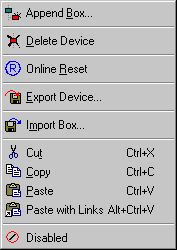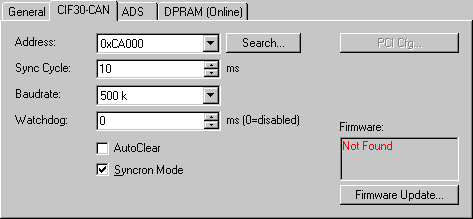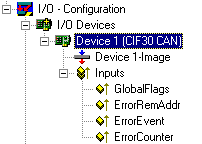Hilscher CIFxx-CAN
The CIF30-CAN is an CANopen ISA master card.
The CIF50-CAN is an CANopen PCI master card.
The CIF60-CAN is an CANopen PCMCIA master card.
The C104-CAN is an CANopen PC104 master card.
The DPRAM of the CIFx0-CAN is 8 Kbytes. There are no interrupts used.
The following description relates to the CIF30-CAN. The other cards vary from the point of view of TwinCAT in form only.
Context menu

Append Box... <Insert>
Adds CANopen boxes.
Currently supports the following boxes (further details on the boxes given later):
Supported boxes | Description |
|---|---|
Bus Coupler | |
Economy Bus Couplers | |
Bus Coupler | |
Low-Cost Bus Couplers | |
General CANopen device. |
Delete Device... <Del>
Removes the CIF30-CAN fieldbus card and all subsidiary elements from the I/O configuration.
Online Reset
Initiates an online reset on the CAN bus.
"CIF-30 CAN" tab

Address: Enter the DPRAM card address here (CIF30-CAN and C104-CAN). This address is jumped/configured on the card and can assume the following values: from 0xC8000 to 0xEE000 in steps of 0x2000
PCI Slot/Ring: (CIF50-CAN) Indicates the logical PCI slot into which the card is inserted.
Search: Searches the computer for available CIF-30 cards (only when TwinCAT is active)
Synch Cycle: Enter the cycle time for the synch telegram send.
Baudrate: Used to set the baud rate used for CAN bus operation.
Watchdog: Watchdog, used by the CANopen card to monitor TwinCAT.
AutoClear: If you select this box, a node failure will halt the whole network. Otherwise, the system attempts to re-incorporate the node and continues operating.
Synchronous Mode: The highest priority task linked with a corresponding device controls the fieldbus cycle and is thereby synchronized with the fieldbus I/O update (but not with CANopen SYNC; this is an independent card function). All other tasks are served asynchronously via corresponding buffers.
Firmware Update... Update the CIF-30 CAN firmware version here. The currently loaded firmware version is shown in the window - in red if the TwinCAT recognizes and is awaiting a more recent version.
Input Diagnosis

The CIF-30 automatically provides four input bytes which describe the status of the card and the CAN bus:
GlobalFlags: The individual bits have the following definitions:
- 0x01 = Ctrl: Parameterization error
- 0x02 = ACtrl: Device stopped communication because of a guarding error at a node.
- 0x04 = NData: At least one node failing to communicate or has a configuration error
- 0x08 = Fatal: Serious bus error occurred
- 0x10 = Event: Communication error recognized
- 0x20 = NRdy: Host is not ready
ErrorRemAddr: Address of the node sending the signal, address 255 is the master card itself
EventError:
If ErrorRemAddr is other than 255 the following applies:
- =30: Guarding malfunction
- =31: Node has changed status
- =32: Sequence error in guarding protocol
- =33: No answer from remote frame PDO
- =34: No answer during a node configuration
- =35: Incompatible node profile number
- =36: Incompatible node device type number
- =37: Unknown SDO response received
- =38: SDO syntax error
- =39: Node in STOP mode
If ErrorRemAddr 255 appears the following applies:
- =52 unknown Handshake Mode has been configured
- =56 baud rate not defined
- =60 node address has been duplicated
- =220 host watchdog error
- =210 no database
- =212 database error
ErrorCounter: Number of errors to have occurred